History and description
The building has a historic core dating back to the 16th century, which was enlarged between the 17th and 18th centuries with the addition of an enclosed structure on Via Amedei by the Roman Giovanni Ruggeri. [1] The more historic central courtyard survives today, featuring a portico on all four sides characterized by columns with terracotta lintels and roundels on the spandrels.
The later addition created a second courtyard connected to the inner courtyard by a loggia with six columns. Inside, there is a fine staircase with a wrought-iron parapet leading to the main floor, where the master's apartments were located, adorned with stucco and wall decorations. The eighteenth-century façade was originally constructed in rough brick and later plastered. Access to the building is provided by an elegant arched doorway, surmounted by a fine wrought-iron Baroque balcony. At the end of the 18th century, the coats of arms on the terracotta medallions in the spandrels of the arches were lost, chiselled away by the partisans of the Cisalpine Republic. However, according to Paolo Mezzanotte, [2] the hanging capitals bear a strong resemblance to those removed from the great cloister of the Monastery of Santa Maria del Lentasio.
In the early 18th century, the palace belonged to the Litta family and later passed to the Recalcati and Prinetti families. Even at the beginning of the 19th century, there were reports of vast gardens extending behind the palace, which have since been lost. The palace underwent restoration during the post-war period.

The Palazzo Litta, also known as the Palazzo Arese-Litta, is a Baroque structure in Milan, northern Italy, opposite San Maurizio al Monastero Maggiore, and dating from the period of Spanish rule of the city. In 2018, it served as a cultural center, housing exhibition spaces, offices, and a theater.

Villas and palaces in Milan are used to indicate public and private buildings in Milan of particular artistic and architectural value. Milan has always been an important centre with regard to the construction of historical villas and palaces, ranging from the Romanesque to the neo-Gothic, from Baroque to Rococo.

Palazzo Marino is a 16th-century palace located in Piazza della Scala, in the centre of Milan, Italy. It has been Milan's city hall since 9 September 1861. It borders on Piazza San Fedele, Piazza della Scala, Via Case Rotte and Via Tommaso Marino.
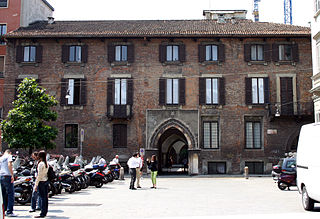
Palazzo Borromeo is a 14th-century building located at piazza Borromeo 12 in Milan, region of Lombardy, Italy. It was built as the home and business headquarters of the Borromeo family, merchant-bankers from Tuscany. Some of the building complex was badly damaged during World War II in Allied bombings of 1943 but was reconstructed and restored to its 15th-century appearance. It contains an important fresco cycle from the 1440s and is one of the finest examples of a Milanese patrician palace from the early Renaissance.

Palazzo Mezzanotte, also known as Palazzo delle Borse is a 20th-century building of Milan, Italy, and the seat of the Italian stock exchange. It is located in Piazza Affari, the city square after which the Italian stock exchange itself is nicknamed. The name "Palazzo Mezzanotte" is a reference to Paolo Mezzanotte, the architect who designed the building.

The Palazzo Tarsis is an 18th-century mansion in Milan, northern Italy, built in the Neoclassical style. Its interiors were fully renovated after the building was bombed in 1943. Historically part of the Porta Nuova district, it is located at 1, Via San Paolo.

The Palazzo Zambeccari at 11 Via Carbonesi is a Neoclassical urban palace in central Bologna, region of Emilia-Romagna, Italy. It is located diagonal to the facade of San Paolo Maggiore, and in 2015 was home to offices of the Banco Popular di Milano SCRL.

Palazzo Arese was a 16th century baroque palace and seat of a branch of the House of Arese in Milan, Italy. It was located adjacent to Casa Fontana Silvestri near the Porta Orientale. The palazzo was demolished in 1943 following damage sustained during the bombing of Milan in World War II.
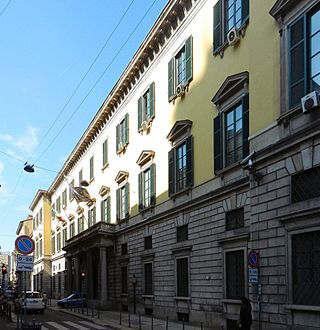
The Prefecture, Milan, also known as Palazzo Diotti, is a historic neoclassical building which has been the location of the office of the Prefect of Milan since 1859. The building is situated at 31, Corso Monforte in the city.

Palazzo Cornazzani is a palace in Pavia, in Lombardy, where, between 1895 and 1896, Albert Einstein lived.

Palazzo Durazzo-Pallavicini or Palazzo di Gio Agostino Balbi is a building on Via Balbi in the historic city centre of Genoa. On 13 July 2006 it became one of 42 palazzi included in the new Palazzi dei Rolli World Heritage Site.

Palazzo Carmagnola is a palazzo quattrocentesco in Milano, which was remodelled several times in the following centuries. Historically belonging to the Sestiere di Porta Comasina, it is located in via Rovello 2.
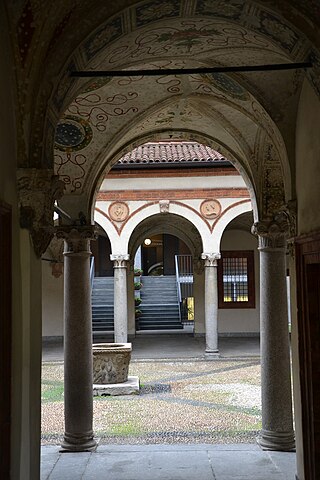
The Palazzo Dal Verme was the noble residence of one of the most powerful families of the Visconti and Sforza court in the 15th century. The courtyard remains today, one of the greatest examples of civil construction from the Renaissance era in Milan. It is located at 3 Via Giacomo Puccini.
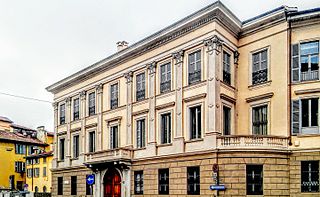
Palazzo Marietti is a historical building in Milan located in Via del Bollo No. 2.
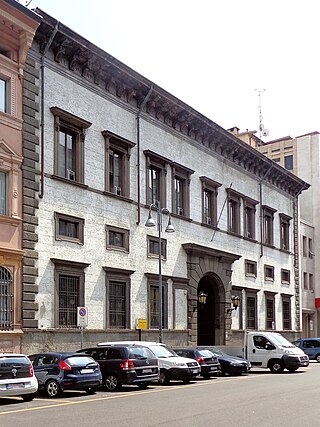
Palazzo Spinola is a 16th-century palazzo in Milan, heavily remodelled during the 19th century. Historically belonging to the sestiere di Porta Nuova, it is located at 10 Via San Paolo. Since 1808 it has been the seat of the Garden Society.

Palazzo Visconti di Grazzano, also known as Palazzo Visconti di Modrone or Palazzo Bolagnos, is a historical palace located in the centre of Milan, in Via Cino del Duca no. 8.
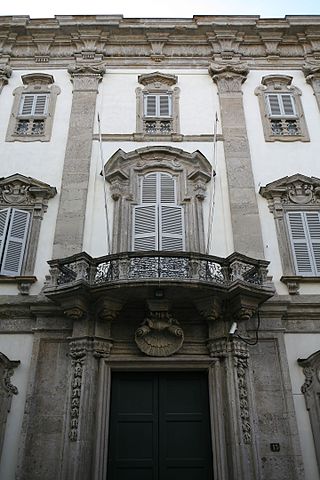
Palazzo Cusani is a 17th-century palace in Milano, remodelled a first time between 1712 and 1719 and a second time between 1775 and 1779. Historically belonging to the sestiere of Porta Nuova, it is located at via Brera 13–15.
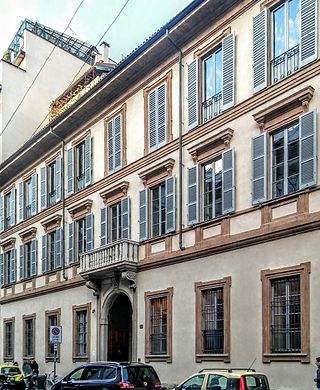
Casa Piumi is a historic building in Milan located at 17 Via Pantano.
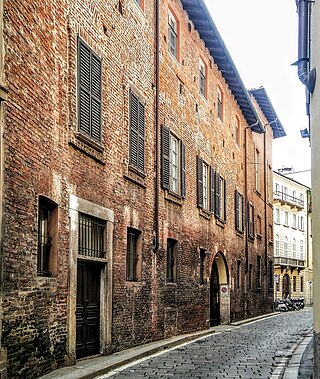
Casa Radice Fossati' is a historic building in Milan located at via Cappuccio no. 13




















